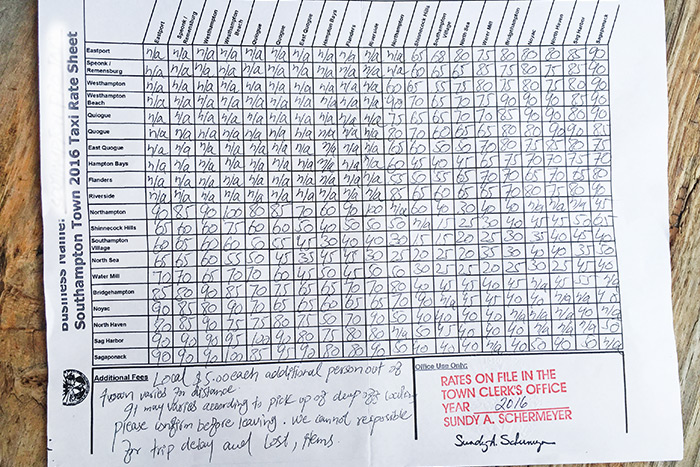Taxi! Taxi! Regulations and Rates and Rules and Licenses

If you get into a taxicab anywhere in Southampton, you should see a list of rates for different rides on a sheet that is posted in the car’s driver’s side rear window. This document is also the license from the town to be a taxi. The driver’s credentials checked out. He or she has been fingerprinted and background-checked by the town police before the license is awarded. The list/license must be posted.
This sheet is being misused, though, or at least it was in a ride that was recently brought to my attention. The cost of a ride from the Omni to the Atlantic Golf Club, a distance of just four miles, was quoted at an outrageously high sum. This was after the ride was completed. Rider beware. When the passenger complained, the driver said he’d actually discounted the price. He pointed to his rates posted in the window. “These are the rates approved by the town,” the driver said.
“These are town rates?”
“Yes. Official town rates. It says so.”
He pointed to a headline across the side of the sheet that read SOUTHAMPTON TOWN 2016 TAXI RATE SHEET. And he noted that on the bottom it reads RATES ON FILE IN THE TOWN CLERK’S OFFICE YEAR 2016. It was embossed with the town seal.
Could these high prices actually be the town taxi rates?
I called the Town Clerk to ask about this, and was told that no, these weren’t the town prescribed rates. The town doesn’t list rates. It asks the taxi drivers to write their rates, and so these were the taxi-offered rates.
“Some of them are outrageous,” Town Clerk Sundy Schermeyer offered.
And indeed they are.
It was obvious to me that these rate sheets, made by the cab company or the individual licensed driver, not by the town, are pretty much a license to overcharge. They enter outrageous numbers. Then the town stamps it and approves it. The embossed seal had raised lettering.
“Our stamp just announces they’ve been approved as a licensed taxi driver. We stamp them and so taxi drivers can’t use a copy machine and monkey with the rates they’ve written,” Schermeyer told me.
Neither she nor anybody else in the Town Clerk’s office had noticed this easy way a cab driver could delude a customer to accept high rates. When I pointed it out, she said she saw what I’m talking about, and she will have the document modified so it can’t give that impression.
It is good that this will be fixed, but it will take a bit of time to get the change out into the system with new forms, and I doubt you will see it fixed before the season ends.
As a result of this, and because I was now curious, I began to look into the rates charged and licensing procedures in both Southampton and East Hampton. The situation is complex and fluid. It’s a situation that needs to be better regulated to avoid certain problems.
A year or so ago, a Taxi Commission was established by Suffolk County and I have not yet contacted them, but with all the towns and villages involved and the fact that taxicabs move freely among them and can come in from out of town and go back out again, this is going to be a big job.
In East Hampton, companies must have local East Hampton offices for their cabs, and these offices must be headquartered in the town. This means cabs owned by outsiders (from Brookhaven, Water Mill, Kalamazoo, New York City, Uruguay, etc.) are not licensed to pick you up in that town. No other town has this restriction. In East Hampton, East Hamptonites take care of the taxi business.
Also, East Hampton, unlike Southampton, does not require lists of rates to be posted in the taxis. So you need to ask before you get in, which is not a bad idea wherever you get in a cab. I have found out by checking some of these cabbies out in some of these locations that the taxis are for the most part quite clean and the drivers are nice. I did ask about a price from point A to point B and did not find anyone who was giving me an out-of-bounds rate. All had local licenses (which cost about $1,000 a year) posted.
I do think that the county, with its new commission, should require that a phone number for complaints be posted in a cab, as you see elsewhere, and that the county gather up for this purpose files on each of the cabs licensed in each of the towns, so that complaints can be monitored. If a cabbie is not doing his job right for one reason or another, a commission needs to know, and such a commission could recommend to a town that a license be pulled and show the evidence of a litany of complaints.
As you know, the eastern end of Long Island is a crazy quilt of town and village jurisdictions. At the present time, some of the villages have no regulations for taxicabs, relying on the towns that surround them for regulation. They should regulate inside the villages, too.
I wonder what Sag Harbor does? The Village of Sag Harbor is divided between two towns. From the centerline of Division Street (which runs right through the center of town) to the east you are in East Hampton Town and from the centerline to the west you are in Southampton Town.
Ms. Schermeyer, who is fixing the easily misunderstood license and rate sheet in Southampton, noted that this thing gets even more complicated. On the bottom of the sheet for Southampton, there is a space for the cab company to write what additional charges might accrue. The one I have a copy of says “Local $5.00 each additional person out town varies with distance.” This is not good English.
“There will be a charge for $25 if you throw up in the car,” Schermeyer told me was one of the more interesting comments she’s read.
There is also the fact that an out-of-town cabbie with no license can jump a line of cabs to the front and create an uproar, and what’s to be done about it?
Things now are just so much different than they used to be. A long time ago, I was at the Montauk railroad station late one night when Sidney Lumet was filming a scene for the movie Deathtrap. The train pulls into the station and just one passenger gets off, a young novelist played by Christopher Reeve. He had hoped to get off at Water Mill, but he slept through that station. Now he’s at Montauk, talking to the single cab driver there, an older woman sitting in a 20-year-old station wagon with the engine running and black oil smoke belching out the back, waiting for him.
“Where to, fella?” she asks.
“Where am I?” he wonders.
All the way back to Water Mill, she gets him up to date with all the local gossip in this small fishing town. Reeve listens patiently.
And, by the way, Uber is coming to Southampton. It will probably be in business by the time you read this. Uber officials left a meeting with East Hampton officials last year when told everybody would have to have a taxi office in that town. But there is no such law in Southampton. So again, as in Sag Harbor, what happens with Uber when you cross over from an Uber town to get to an Uber-free town, and then need to get back out?
Taxi regulation is a work in progress here. The county commission number is 631-853-4600.



